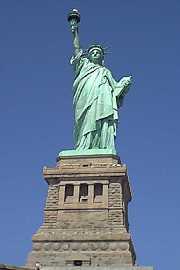Immigration

Statue of Liberty National Monument
The Statue of Liberty, one of the most universal symbols of America, was actually a gift from the people of France. Conceived as the embodiment of political freedom and a gift of international friendship, "Liberty Enlightening the World" (the Statue's original name) has become a beacon for people both commemorating and still in search of freedom and opportunity. The Statue of Liberty was dedicated in New York Harbor during a formal ceremony on October 28, 1886. The colossal statue was designated a National Monument by Presidential Proclamation on October 15, 1924 during the Coolidge administration and was transferred from the War Department to the Department of the Interior, National Park Service under the Act of March 3, 1933. The Statue was extensively conserved and restored in the early 1980's and celebrated her centennial in style on July 4, 1986. In 1984, the Statue was designated as a World Heritage Site.
Nearby Ellis Island was incorporated as part of the Statue of Liberty National Monument by President Lyndon Johnson on May 11, 1965, in recognition of the island's former function as an immigrant inspection station and a temporary shelter for approximately 12 million people who sought refuge, freedom and opportunity in the United States between 1892 and 1954. Reopened to the public on September 10, 1990 after a massive $162 million restoration, the Main Building on Ellis Island is now a museum dedicated to the history of the Ellis Island Immigration Station.
- Bering Land Bridge National Preserve
- Castle Clinton National Monument
- Statue of Liberty National Monument
Related Links:
- A History of Japanese Americans in California: Immigration
- El Centro Espa-ol de Tampa
- International District (Seattle Chinatown Historic District)
- Statue of Liberty National Monument - Historical Handbook Series
- Teaching With Historic Places: Immigration Lesson Plans
- U.S. Immigration Station, Angel Island